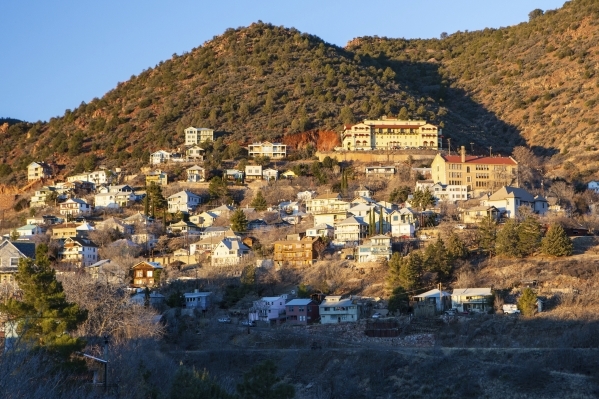For a ghost town, Jerome remains quite lively

Jerome, Arizona’s liveliest ghost town, has turned the bust of its mining wealth into a boom of tourism income. Instead of extracting the copper, gold and silver of old, Jerome now exploits its colorful past, picturesque downtown, splendid setting and thriving arts community to entice visitors.
Located on a mountainside in central Arizona, Jerome straddles scenic Highway 89A and overlooks the beautiful Verde Valley with the striking red cliffs of Sedona in the distance.
The former copper boomtown of Jerome is 285 miles from Las Vegas. Follow U.S. Highway 93 to Kingman, Ariz., then head east on Interstate 40. At Ash Fork, turn south on Highway 89 and drive 45 miles toward Prescott. Watch for the turnoff for 89A as you approach Prescott. Turn there and head east about 26 miles to reach Jerome. The dramatic route will take you over Mingus Mountain and steeply down toward the Verde Valley. This is not a safe route for large RVs or vehicles hauling long trailers. Oversize rigs should approach using other routes from Prescott or Flagstaff.
The curvy highway takes hairpin turns through the old town, its bridges cantilevered over the slopes. Jerome’s precipitous streets are terraced from the mountainsides with the backs of buildings supported by posts and frameworks.
Listed as a National Historic Landscape in 1976, Jerome features vintage buildings that crowd the town’s three levels. Visitors find parking in lots and along streets and explore the commercial district on foot. During busy times, a town trolley assists tourists. Jerome draws crowds, especially on weekends, holidays and during special events.
The downtown offers a mine museum, a variety of shops, 30 art galleries, a choice of eateries and bars, wine-tasting rooms, quaint hotels and charming bed-and-breakfast inns. Popular events include monthly First Saturday art walks, when galleries and artists’ workshops stay open later and offer beverages, snacks and live music. October is usually a busy month with guided ghost walks, scary tales and a Halloween costume dance. Ask about special events at the Jerome Chamber of Commerce.
Some of Jerome’s attractions are located outside of the downtown. Many artists have workshops in Jerome’s former high school at the edge of town, reached by the trolley or by car. The mile-long approach to the site of old Haynes and the Gold King Mine starts at the Jerome Fire House. Visitors find eclectic collections of memorabilia, mining equipment and assorted original and replicated buildings.
No visitor should miss the Jerome State Historical Park, which occupies the 1916 Douglas Mansion just below downtown. The Southwestern-style residence built of adobe by mining magnate James S. Douglas for his family and guests was added to Arizona’s state park system in 1965. Exhibits, information and a video provide a good introduction to Jerome and its history. Visitors enjoy panoramic views and picnicking on the grounds. A small entrance fee is charged.
Standing adjacent to the mansion is the weathered Audrey Shaft Headframe, a wooden structure built in 1918 that is the oldest remaining in Arizona. Preserved by the Jerome Historical Society, the site features a glass cover over the mine shaft, allowing visitors to look directly down into the 1,900-foot hole.
Jerome began with claims staked in 1876 near former Spanish copper diggings that were bought out in 1883 by the United Verde Copper Company. The little tent camp was named for the chief investor, Eugene Jerome. High transportation costs caused the venture to founder within two years. When a narrow gauge railroad was built to the site by William A. Clark, the mine began to prosper. By the turn of the 20th century, it was the largest copper mine in Arizona Territory. In 1912, Douglas began developing the Little Daisy, Jerome’s second bonanza mine.
Jerome survived fires and landslides and rebuilt with brick and wood as it grew to a city of 15,000. Copper production peaked in 1929, the year the Great Depression began. When declining ore quality closed the last mine in 1953, just 50 residents remained. They fought to keep the town intact. An influx of urban refugees and artists in the 1960s stimulated a revival, giving new life to old Jerome.
— Margo Bartlett Pesek’s Trip of the Week column appears on Sundays.